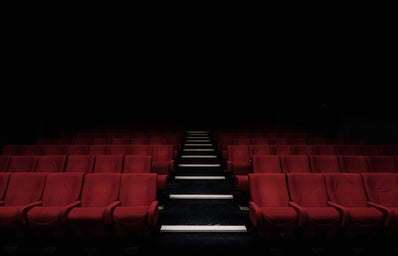The year was 1896. A lot of people from the fluminense high society went to the Petrópolis, a city in Rio de Janeiro, to see the arrival of a new invention: the movie theater. Vista da Baía de Guanabara, the first Brazilian original movie was made in 1898, June 19, by the Italian productor Alfonso Segreto, when he arrived at Brazil in the ship Brésil. Since that time, June 19 is considered the Brazilian Movie Day.
Though having a day, movies in Brazil have faced adversities since their beginning. In the end of the Nineteenth century and in the first years of the 1900s, going to the movie theater to see a picture was an privilegie of the high society. With the exhibition centres concentrated in the cities of São Paulo and Rio de Janeiro, the tickets were very expensive and the majority of the Brazilian population lived in rural areas.
Price continued to be a problem even with the expansion of the movie theater to other parts of the country, such as Recife and Belo Horizonte. The 1930s and the 1940s were marked by the rising of the first Brazilian studios, such as Cinédia and Atlântida Cinematrográfica, focused in movies that followed the Hollywood patterns, as the movies with Carmen Miranda, and in popular comedies, called chanchadas. However, when the studio Vera Cruz, created in 1949, tried to make more structured pictures, such as O Cangaceiro, from Lima Barreto, it had to close because the costs were very high.
In that time, another problem became bigger: the dangerous blend of politics and pictures. Getúlio Vargas, Brazil’s president from 1930 to 1945 and to 1950 to 1954, created the first law to support Brazilian movies and said that pictures should help to build a common Brazilian identity among the population. Nevertheless, the attitudes of the president were deeply broadcasted in the movie news, short journalistic programa that used to be broadcasted in movie theaters before the pictures, and during the Estado Novo, a low democratic age that lasted from 1937 to 1945, all artistic productions were forbidden to criticize the government.
Affonso Segretto and the early projectors of the Paschoal Segretto Company, the forerunner of cinema in Brazil (Image Source: Public Domain)
These situation became worse after the beginning of the Military Dictatorship, in 1964, when was instituted censure to the journalistic and artistic activities. The 1960s saw the rising of Cinema Novo, a movement that aimed to get from the Hollywood model, trying to make pictures with more realistic characters, that showed the poverty and the political problems of the nation. The main productions of that time are Deus e o Diabo na Terra do Sol (1964), that portrays the conflicts of the Northeast of Brazil, and Terra em Transe (1967), about a revolution in Eldorado, a fictional country, both of Glauber Rocha.
So, with the military government, the pictures had to find more subtle way to make social and political criticism. The solucion was the movement called Tropicalismo, that happened not only in pictures, but also in other cultural spheres, such visual arts and music. The main point of Tropicalismo was to use metaphors and aesthetic innovations to show the contradictions of the country. The greatest example is the movie Macunaíma (Joaquim Pedro de Andrade, 1968), based on the book of Mário de Andrade, that tells the story of Macunaíma, an indigene with dubious moral principles that travels around the country.
Paradoxically, from 1969 to 1990, Embrafilmes (Empresa Brasileira de Filmes Sociedade Anônima), an estatal company, launched more than 200 pictures. The annual budget was around U$ 200 millions and they used to produce 25 movies per year, including Dona Flor e seus Dois Maridos (1976), that took more than 10 million people to the movie theater, an audience bigger than any foreign movie had reached in Brazil until then. Although, in the end of the 1980s, Embrafilmes was accused of bad administration and excuse relation with politicians, situation intensified by the global economic crisis caused by th price of oil. In 1990, the first year of president Fernando Collor´s administration, the company was closed.
The hit was big: in 1992, only one original movie went to the screens: A Grande Arte, spoke in English and made by Walter Salles. The stagnation of that time was responsible for the low audience that national íctures have today in Brazil. The scenery started to change in the middle of 1993, with the attenuation of the crisis and the Audio-visual Law, promulgated by president Itamar Franco, that grants tax deduction for those who wants to make audio-visual productions.
Sônia Braga, Mauro Mendonça, and José Wilker in Dona Flor e Seus Dois Maridos (1976) (Image Source: IMDb)
Then, a movement called Cinema de Retomada, inaugurated with the Carlota Joaquina, Princesa do Brazil, made by Carla Camurati, that took more than a million people to the movie theaters. Still in 1995, fourteen films were launched. The number of viewers increased from 800 thousand in 1996 to more than 22 millions in 2003. In 2001, was created Ancine (Agência Nacional do Cinema), responsible for boost and regulate the audio-visual national production. The public incentives of that time enabled a technical improvement in the pictures, which also contribute to rise the audience.
The end of the 1990´s and the beginning of the 2000’s saw the release of famous Brazilian movies, such as Central do Brasil (1998, Walter Salles), nominated to the Oscar for Best Foreign Movie, O Auto da Compadecida (2000) and Lisbela e o Prisioneiro (2003), both directed by Guel Arrares. These two were made by Globo Filmes, that normally uses in the pictures the same aesthetical structure of their soap operas.
The rise of the new millennial were also marked by the Favela movies, that mix violence, police themes and fight against drug trafficking. In this category, there are Cidade de Deus (2002, Fernando Meirelles, Kátia Lund), Tropa de Elite (2007) and Tropa de Elite 2: O Inimigo Agora é Outro (2010), booth of José Padilha and the last saw by 11 million people, the Brazilian movie with the high audience from all times. Also, this period brought some new narratives and a new kind of social criticism to the big screen, for example, the Que horas ela volta (2015, Anna Muylaert), about the relationship between a house made and her bosses, and Bruna Surfistinha (2011, Marcus Baldini), about the trajectory of a prostitute.
Deborah Secco in Bruna Surfistinha (2011) (Image Source: IMDb)
Unfortunately, the national audio-visual productions are again facing difficult times in Brazil. The current Brazilian president, the rightist Jair Bolsonaro, and some members of his administration, had some attitudes that are very close to what can be called censure. Last August, the debut of Marighella (Wagner Moura), picture about Carlos Marighella, a strong opponent of the Military Dictatorship, was canceled in Brazil after Ancine denning a refund of R$ 1 million, spendend during the production. In September, the president cut the budget of Fundo Setorial do Audiovisual, the main funding body of the national audiovisual productions, in 43%. In the same month, Ancine suspended the help that would be granted to Greta and Negrum3, movies about homossexuality and racism, to took part in the Festival de Cinema Queer de Lisboa. In times like, that threaten the artistic freedom, the support of the public is essential to the permanence of the Brazilian original productions.


